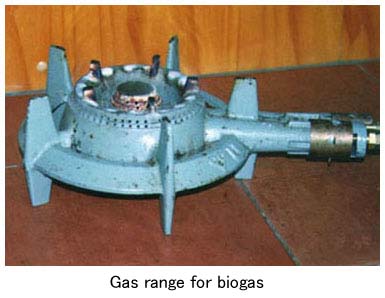The biogas system with septic tank(EMG,Ozeki)
The amount of water used in a normal toilet is too much to allow biogas to form. A marine toilet is used in the house which flushes 280cc of water a time. This amount of water is not enough to create biogas and so a seat with a water sprayer has been attached. This decreases the use of toilet paper which uses energy to produce, and also creates pollutants during its manufacture. Bodily waste and garbage from the kitchen are taken to the first section of the tank where, after an aerobic process, the sunken material moves to the next section along the slope. There biogas starts to be produced by methane bacteria which can be active above -20�Ž. In this section the biogas is stored and from there passes through a deodorant filter before reaching the cooking range in the kitchen. Pressure is monitored on a gauge which usually shows from 8kpa to 13kpa depending on the amount of input. There is little residue, but in order to allow inspection of the water level, the third section of the septic tank has a manhole. An important feature of this system is that all organic materiai is changed into biogas. Currently organic exhausts are burnt or dumped in rivers or at sea. The former process wastes a lot of energy and the latter damages the river or the sea with too many rich nutrients.
.


